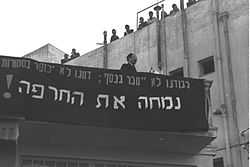Wiedergutmachung


The German word Wiedergutmachung after World War II refers to the reparations that the German government agreed to pay in 1953 to the direct survivors of the Holocaust, and to those who were made to work as forced labour or who otherwise became victims of the Nazis. The sum would amount, through the years, to over 100 billion Deutsche Mark. Historian Tony Judt writes about Wiedergutmachung:
- In making this agreement Konrad Adenauer ran some domestic political risk: in December 1951, just 5 percent of West Germans surveyed admitted feeling ‘guilty’ towards Jews. A further 29 percent acknowledged that Germany owed some restitution to the Jewish people. The rest were divided between those (some two-fifths of respondents) who thought that only people ‘who really committed something’ were responsible and should pay, and those (21 percent) who thought ‘that the Jews themselves were partly responsible for what happened to them during the Third Reich.’ When the restitution agreement was debated in the Bundestag on March 18th 1953, the Communists voted against, the Free Democrats abstained and both the Christian Social Union and Adenauer’s own CDU were divided, with many voting against any Wiedergutmachung (reparations).[1]
The noun Wiedergutmachung is the general term for "restitution" or "reparation". The noun is made up of wieder ("again"), gut ("good" or "well"), and machung, a verbal noun of machen ("to make"). The verb wiedergutmachen means literally "to make well again" or to compensate. Wiedergutmachungsgeld means "Wiedergutmachung money".
In the former East Germany, Wiedergutmachung was mostly directed to Poland and the former USSR.
The German federal office in charge of this issue is BEG (abbreviation for "Bundesentschädigungsgesetz", which translates into English as "Federal Compensation Law") which, in its charter, states:
- Individuals who were persecuted for political, racial, religious or ideological reasons by the wartime German regime are eligible for money from the German government under the terms of the Federal Compensation Law (BEG) of 1953 and 1956. This includes Jews who were interned in camps or ghettos, were obliged to wear the star badge, or who lived in hiding.
Only people who were directly victimised are eligible for Wiedergutmachung, and not, for example, offspring born after the war or grandchildren. Statistics concerning Wiedergutmachung payments were released by the BEG through the mid-1980s, but have not since been publicly released. As of the mid-1980s, over four million claims had been filed and paid. Approximately 40% of the claims were from Israel, where many Holocaust survivors live, 20% were from Germany, and 40% were from other countries.
An unusual compensation was to the Republic of Ireland, a neutral country, for bombings in 1941.
On 3 December 1998, Germany was a signer of the "Washington Principles on Nazi-Confiscated Art",[2] in which Germany agreed:
1. Art that had been confiscated by the Nazis and not subsequently restituted should be identified.
2. Relevant records and archives should be open and accessible to researchers, in accordance with the guidelines of the International Council on Archives.
3. Resources and personnel should be made available to facilitate the identification of all art that had been confiscated by the Nazis and not subsequently restituted.
4. In establishing that a work of art had been confiscated by the Nazis and not subsequently restituted, consideration should be given to unavoidable gaps or ambiguities in the provenance in light of the passage of time and the circumstances of the Holocaust era.
5. Every effort should be made to publicize art that is found to have been confiscated by the Nazis and not subsequently restituted in order to locate its pre-War owners or their heirs.
6. Efforts should be made to establish a central registry of such information.
7. Pre-War owners and their heirs should be encouraged to come forward and make known their claims to art that was confiscated by the Nazis and not subsequently restituted.
8. If the pre-War owners of art that is found to have been confiscated by the Nazis and not subsequently restituted, or their heirs, can be identified, steps should be taken expeditiously to achieve a just and fair solution, recognizing this may vary according to the facts and circumstances surrounding a specific case.
9. If the pre-War owners of art that is found to have been confiscated by the Nazis, or their heirs, can not be identified, steps should be taken expeditiously to achieve a just and fair solution.
10. Commissions or other bodies established to identify art that was confiscated by the Nazis and to assist in addressing ownership issues should have a balanced membership.
11. Nations are encouraged to develop national processes to implement these principles, particularly as they relate to alternative dispute resolution mechanisms for resolving ownership issues.
Adherence to these principles is strictly voluntary and not a legal requirement. The Washington Principles cover only items in the possession of public institutions, and not items in the possession of private individuals. Germany has no law in effect which actively requires institutions to have their possessions searched for Nazi-looted goods, unlike the 1998 restitution law in Austria.[3]
See also
References
- ↑ Tony Judt: Postwar. A History of Europe Since 1945, New York 2005, p. 271
- ↑ Washington Principles on Nazi-Confiscated Art
- ↑ "Bundesgesetz über die Rückgabe von Kunstgegenständen aus Österreichischen Bundesmuseen und Sammlungen", see the German Wikipedia Article (in German)
External links
- Electronic Index to Bundesentschädigungsgesetz, in german language.
- Kriegsfolgen und Wiedergutmachung , Ministry of Finance (Germany), Portal Site, in German language.